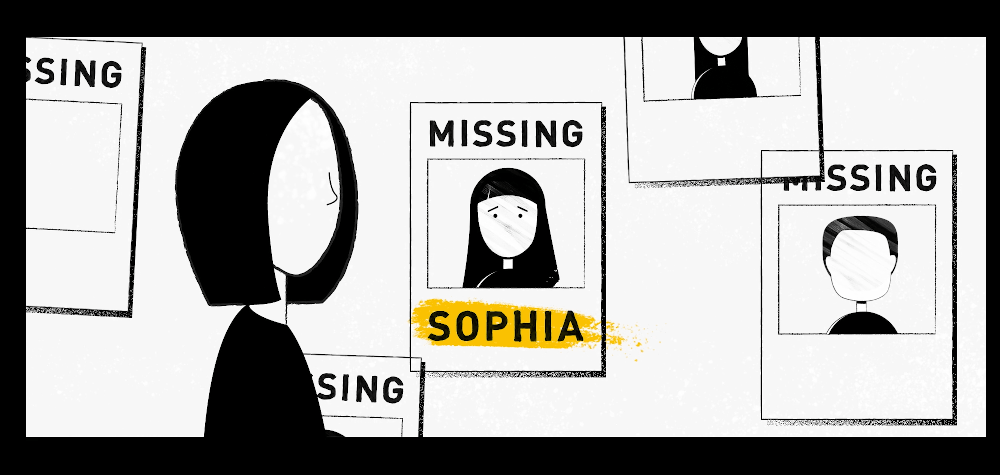Global anti-trafficking organisation A21 marked its 10th birthday last week with the release of a film called Missing Persons. It was a significant week for Aussies working to stamp out modern slavery, with the the Modern Slavery bill 2018 passing the NSW Parliament, with the backing of Premier Gladys Berejiklian (read the full story here).
A21 supporters equipped with a social media kit held more than 1300 hundred ‘screening parties’ for Missing Persons in 50 countries across the world.
NSW Premier urged to bring Modern Slavery Act into force
A virtual rally to end modern slavery in NSW is starting now
Anti-slavery activists call on WA to update industrial laws
4000 slaves in Australia mean we have work to do
Missing Persons chronicles the evolution of A21 from its launch with just a few staff on the ground in Greece a decade ago to a respected, growing organisation executing a sophisticated, ‘multi-pronged’ attack on modern slavery in 13 countries. More importantly, the film provides a glimpse of the real life stories of human trafficking survivors that are the reason for everything A21 does.
A21 co-founder Christine Caine explains how it all began ten years ago in an airport.
“I went to Thessaloniki… there’s a little carousel, a little baggage claim. I saw all these posters of these young women and children,” Christine says.
“What struck me was just the sheer number of them. I’m looking at all of these faces. I kept reading the word MISSING, MISSING. MISSING. Then, as I’m looking, the little girl’s name was ‘Sophia’”.
Christine’s own daughter’s name is Sophia and she reflects “that’s my moment … everything changed. I went from looking to seeing what could have been my child. That moment changed everything, because I saw my daughter.”
Christine called her friend at UNICEF to ask about the posters and was informed that the faces she was looking at were most likely the victims of human trafficking. An incredulous Caine replied that surely slavery didn’t exist today, only to learn she was wrong.
Returning home, she began searching for an organisation that was successfully working to abolish human trafficking, enlisting the help of her husband Nick and her staff. She planned to offer her services as a spokesperson and fundraiser, but they discovered at that time anti-trafficking organisations were struggling to make an impact.
“You don’t have successes in this area. It’s hopeless,” they were told.
Being told human trafficking was a hopeless reality was like a red rag to a bull and the Caines launched A21.
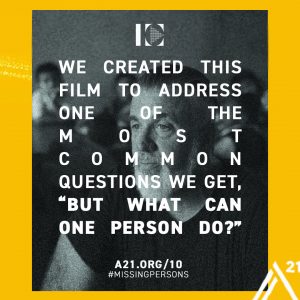
Ten years on, the organisation’s methods are strikingly strategic, with overarching ‘3R’s’ guiding their efforts: Reach the vulnerable; Rescue the victim; Restore the survivor.
And although A21’s many activities do fit neatly within this strategy, their work in 13 vastly different countries is far from a “copy-paste” approach. Instead, the organisation tailors initiatives to match the needs of individual countries.
In six of these countries – Greece, Bulgaria, Ukraine, Thailand, South Africa and US – A21 provides direct assistance to survivors. For example, in Greece, A21’s ‘Freedom Centre’ provides after-care to survivors to help them recover physically and emotionally and so regain their independence.
At the beginning of 2017, A21 opened the Child Advocacy Centre (CAC) in Pattaya, Thailand, in partnership with the Royal Thai Police’s Thailand Internet Crimes Against Children Task Force, and with assistance from the FBI and US Homeland Security Investigations.
On the surface, the CAC simply looks like a centre where children rescued from trafficking and sexual exploitation can play with toys. But in reality, the centre is proving an effective way to unite various partners fighting modern slavery in South East Asia.
Here, children are able to speak in a safe environment to forensically trained interviewers about the exploitation they have experienced or witnessed. To ensure their recovery and rehabilitation is not compromised, experienced CAC workers build trust with the children and remain present during the questioning process to ensure questions are asked in a way that does not re-traumatise the victims.
This allows officers to gather the best possible evidence to prosecute child sex offenders, child traffickers and online crimes against children, while ensuring the victims’ recovery and rehabilitation isn’t delayed by the legal process.
One such victim whose story is told in Missing Persons is a three-year-old girl who was given drugs, dressed in a skimpy costume, painted with adult makeup and forced to dance for seven hours a night, so that she could support a household of three people, paying the rent and electricity. After two years of trying, A21 was able to rescue her in partnership with the Pattaya police and she was brought into the Child Advocacy Centre. Now she is flourishing and top of her class at school.
“Your most crucial evidence is individuals – who cannot just be bagged up and put in a storage room and saved for when you need it for a trial. Their lives go on. And they live with the fear of human traffickers, possibility of being intimidated, even of being trafficked again,” explains Philip Hyldgaard, Executive Director of A21.
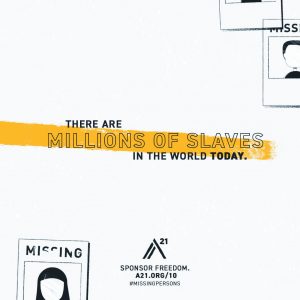
The last ten years have been an adventure for Philip, who went to his A21 job interview at the request of his Bible College Dean, who sent him a message that read, “Hey, Nick would like to meet with you about something in Grease on Friday, could you meet with him?”
Philip was 23 years old, soon to graduate and hadn’t yet landed himself a job. So he quickly agreed, hoping that some kind of ministry initiative called “Grease” was under way that would mean a job for him.
When he met the Caines, Nick immediately launched into a conversation about their A21 plans and human trafficking, under the impression Philip had been briefed about why he was there. His words were met with a dazed look from Philip, who was wondering “Why are you telling me this?”
Philip had never been to Greece (or Grease, for that matter) and didn’t know any Greek. He quickly learned about human trafficking in the job interview, along with the Caines’ plans for A21, watching survivors telling their story on video and learning how traffickers target the most vulnerable in society, such as those in poor or child-headed households.
At the interview’s close, Nick looked at him saying, ‘Well, Phil, it’s not what you were thinking, but what do you think?” Philip replied “I know about the problem now, so I guess I don’t have any choice, I’ve got to get involved.”
Ten years later, Philip remains remarkably hopeful – even confident – for someone who works in a role that would cause many to feel they were attempting to hold back the tide. Yet he’s also a straight-shooting realist when asked whether rescuing victims is actually helpful or whether every person rescued will simply be replaced by traffickers with a new victim.
“That’s why A21 takes a multi-pronged approach,” he explains. “We cannot simply stand at the bottom of the hill and pick up whoever falls down it, so to speak. We also need to put up a fence at the top and prosecute those who throw people off, if that metaphor makes sense.
“We recognise that human trafficking is a huge issue that has multiple factors that drive it, and we must collaborate with governments and civil society to have a holistic approach to truly see it abolished.”
So while the rescue and rehabilitation of victims are at the heart of what A21 does – providing access to medical care for the survivors, repatriation to their home country if needed and much more, so as to restore their independence – prosecuting traffickers is also paramount.
So far, A21’s work has contributed to 81 traffickers being sentenced to a combined total of 1683 years in prison.
“There is no doubt that restoring lives affected by this crime is at the core of A21’s mission, though. We believe that when we are effective in our after-care process we can see survivors not only come back but be stronger than ever – a contributor to society – and their testimony is crucial in bringing justice to the perpetrators,” Philip says.
“When we see traffickers sentenced, it disables them from trafficking others and it sends a very strong message to other traffickers that this is a not a crime to engage in. It increases the risk.”
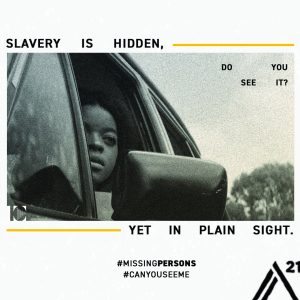
The other important “prong” in A21’s strategy is raising awareness and resourcing the public with information about human trafficking.
In countries such as Australia, awareness-raising looks like hosting a screening party of Missing Persons or taking part in one of the 400-odd locations around the world that hold a public Walk for Freedom.
In Greece, Bulgaria and South Africa, A21 has also established national hotlines that assist callers who want to report something suspicious or who need more information about what to look for. To date, they have received 24,168 calls.
The organisation has also trained 17, 855 frontline professionals in how to identify victims – a crucial tactic in awareness raising.
In the UK, Thailand and US, A21 runs its ‘Can You See Me?’ campaign, advertising on public transport.
‘Can you see me?’ tackles the problem people not being sure of what to look for or how to recognise the signs of sex and labour trafficking, even when they are often in plain sight. So, the campaign is country specific, identifying the most prevalent types of trafficking and informing the public in that country what signs they should look for.
Unlike many ‘awareness raising’ campaigns, the results of the ‘Can you see me?’ campaign have been made measurable through key partnerships with law enforcement, and the national hotlines.
In the UK, the Kent and Essex Police, a key partner in the campaign, provided this feedback:
“Between March 2016 and March 2017, Kent and Essex increased reporting of human trafficking- related crime by 300-400 per cent, and from June 2016 to December 2017 there was also a significant increase in victim identification by a staggering 1200 per cent. The campaign was instrumental in assisting to that rise along with other efforts of the police.”
— Cristina Gavrilovic, Anti-Slavery Partnership Coordinator, Kent and Essex Police
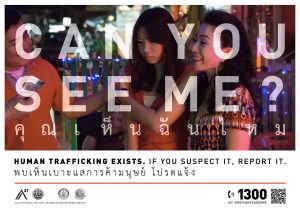
One place where ‘Can you see me?’ features prominently is in airports because, as Global Development Director Christian Eliot explains, airports are “one of the places where the public collides with the victim or the potential victim and therefore an opportunity to prevent that [trafficking] from happening in the first place”.
The campaign provided something of a full-circle moment for Christine Caine recently when at London’s Heathrow Airport.
“I get to the baggage carousel and as I turn around, I see ‘Can you see me?’ I didn’t even really realise what I was looking at.
“If you had told me ten years ago, when I couldn’t look away from Sophia, that I would be standing at Heathrow and around the major airports of the world we would have launched a global ‘Can you see me?’ campaign, I don’t know that I could have believed you.”
Many would argue that, of all people, Caine would most certainly have had the faith to believe it was possible, even ten years ago when A21 was founded.
Asked now “Do you really think we can abolish slavery everywhere forever?” her answer is unequivocal.
“Absolutely,” she replies. “Absolutely.”
